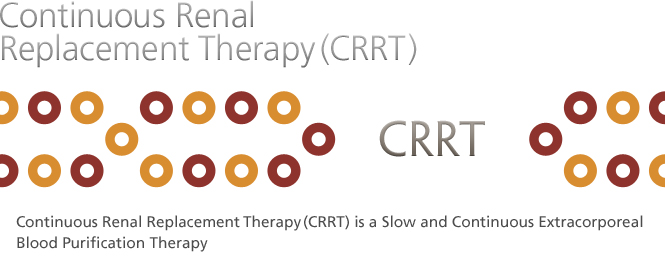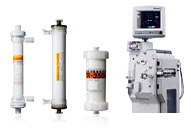- Overview
- Therapies
- Applied
Products - References

Figure shows the relation between the clearance (solutes removal performance) and the molecular weight of solutes in each CRRT modality condition that the total volume of replacement fluid and dialysate in constant (1L/hr). CVVH has superior removal performance for high molecular weight solutes [4].
[4] Naka T, Shinozaki M, Shinozaki. Continuous renal replacement therapy. Kidney and Dialysis. 2000;48:617-21. Japanese

Slow continuous ultrafiltration (SCUF) removes excessive fluid from the bloodstream via ultrafiltration. No dialysate or replacement fluid is used. Main indication is fluid overload without uremia.

Continuous veno-venous hemofiltration (CVVH) removes larger volumes of fluid mainly via convection. Replacement fluid is added. No dialysate is used. CVVH is effective method for removal of large molecules.

Continuous veno-venous hemodialysis (CVVHD) removes fluid mainly by diffusion using dialysate. No replacement fluid is used. CVVHD is effective method for removal of small to medium sized molecules.

Continuous veno-venous hemodiafiltration (CVVHDF) uses replacement fluid and dialysate. CVVHDF combines the benefits of diffusion and convection for solute removal.
Anticoagulation is needed to reduce the clotting of blood in the blood tubing set and filter. Options for anticoagulation include heparin, low molecular-weight heparin (LMWH), citrate, nafamostat mesilate (available in Japan and Korea), and anticoagulation-free. The choice and dosage of the anticoagulation is a decision made by the responsible physician who is familiar with anticoagulation regimen and knows the clinical condition and needs of the patient.
Sterilized bicarbonate-buffered solutions or lactate-buffered solutions are used as replacement fluid.
Vascular access is generally achieved with the use of double lumen catheter placed in a large central vein. Common sites for venous access include the internal jugular vein, the femoral vein and the subclavian vein.
Treatment conditions (e.g., selection of CRRT modality, anticoagulation, replacement fluid vascular access, blood flow rates, ultrafiltration rate, dialysate flow rate, and replacement fluid volume) are decided by the physician in consideration of patient’s conditions (e.g., underlying disease, severity, hemodynamic instability, body weight) and needs.
Ideal function for such equipment include:
- Ease of use
- Accurate control of each pump
- Flexibility to adapt to different treatment modalities (CVVH, CVVHD, CVVHDF, SCUF, pre- or post dilution)
- Flexibility to individualize the blood flow, filtrate, replacement fluid and dialysate flow
- Control of replacement and dialysate fluid to temperature to allow patient temperature management
- Mobile to be used in different locations in the hospital
- Low extracorporeal volume to minimize the risk for hemodynamic instability
- Back-up battery for blood recovery and for maintaining the data in memory in case of power failure
- Ideally be able to perform other types of extracorporeal treatment like therapeutic apheresis (e.g., plasma exchange, double filtration plasmapheresis, plasma adsorption)
Ideal function for such equipment include:
- High permeability and sharp cut-off curve
- Superior biocompatibility
- Low albumin loss
- Long filter patency during the treatment
- Different sizes to accommodate individualized needs
In general high-efficiency hemofilters containing synthetic membrane material are used during CRRT as this membrane material presents the characteristics to match the above requirements.

Please feel free to send us any questions you may have about our products and support.
Share your feelings and experiences when using our products.




